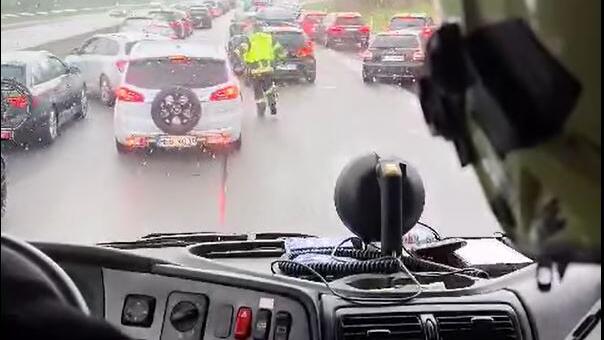Image: FF Ort im Innkreis
In an accident in Ort im Innkreis on the A8 at the weekend, in which two people died, the fire brigade could not drive directly to the scene of the accident. The emergency lane had not been formed properly, a firefighter had to walk and ask motorists to pull to the side.
“Thank God we haven’t had to experience such an extreme case for a long time,” says Markus Voglhuber from the Upper Austrian Fire Brigade Association. It happens again and again that the emergency lane is not formed, but fortunately such incidents are limited, he says. Mario Lindner, an emergency paramedic with the Red Cross, also confirms this. “For us, it’s often about life-saving help that has to arrive quickly. Most of the time, the emergency lane has already been formed and we can drive through unhindered.” However, there are always exceptions.
Up to 2180 euros penalty
Since January 1, 2012, emergency lanes have had to be formed in the event of traffic jams or slow-moving traffic on motorways or expressways. Anyone who does not comply with this or drives in the emergency lane must expect an administrative fine. “The penalties for violations of the rescue lane differ roughly,” says Johann Thumfart from the Upper Austria provincial traffic department. If the rescue lane is used or not formed at all, a fine of up to 726 euros must be expected, the Federal Ministry for Mobility informs on the website oesterreich.gv.at. If emergency vehicles or vehicles of the breakdown service or the road service are obstructed, the penalty is up to 2,180 euros.
“It’s not difficult”
But it doesn’t help the emergency services “if drivers get a penal notice two weeks later,” says Voglhuber. The one driver who has received a penalty would know next time how to form the rescue line, “but then there are still many who have not received a penalty”. Awareness raising is therefore much more important, “so that the vehicle drivers know how I have to react, how do I form the rescue lane”. A little over a year ago, Asfinag launched an advertising campaign on this topic. That helped, says Vogelhuber. “It’s not difficult: those driving on the left drive to the left, everyone else to the right.” Emergency services would save about two minutes on their way to the scene of the accident if the track was free.
This vote is disabled
Please activate the category targeting cookies in your cookie settings to view this item. My cookie settings
The emergency lane would be a challenge for some, especially on three-lane motorways, says Christoph Pollinger, spokesman for Asfinag. In general, however, the formation of the rescue lane “has worked very well for years, it has become routine”.
The Asfinag video explains how the rescue lane is formed correctly:
Source: Nachrichten




